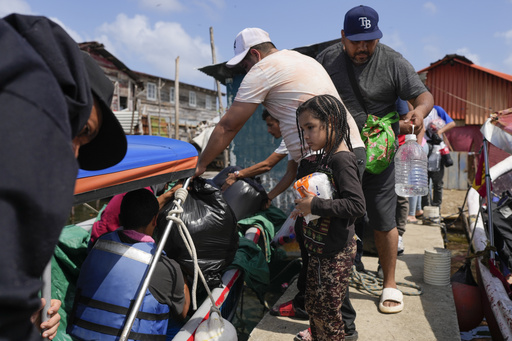PUERTO CARTÍ, Panama — Migrants who once traversed the treacherous jungles of the Darien Gap, making arduous journeys between Colombia and Panama in hopes of asylum in the United States, are now reversing their course. After facing significant obstacles, particularly during the Trump administration’s stringent asylum policies, many have opted to return to their home countries instead of pursuing a once-promising dream.
On a recent Sunday, a speedboat carrying approximately 20 migrants zipped through the lush, dense rivers bordering Colombia and Panama. They huddled together, clinging to their belongings and trying to shield themselves from the splashing water as they ventured back south.
The discouraging environment surrounding U.S. immigration policy has led to what authorities are calling a “reverse flow” of migrants. Many people had previously spent months, if not over a year, in Mexico hoping to schedule an asylum appointment via the Biden-era CBP One app, which came to an abrupt halt during Trump’s tenure. “When Trump arrived and eliminated the application, all our hopes went up in smoke,” expressed Karla Castillo, a 36-year-old Venezuelan who was traveling with her younger sister.
This shift has resulted in speedboats traveling from rural Panama, carrying groups of migrants back to Colombia. A process that used to support numerous smugglers now sees them adjusting their business strategies as many returning migrants are being charged between $200 and $250 for the boat rides, even including minors. Many families use funds transferred through apps like Zelle, often representing their last financial resources following a lengthy search for a better life.
Castillo struggled with her feelings about this retreat. Originally, she and her sister were part of a large wave of Venezuelans fleeing to neighboring countries such as Chile, Peru, and Colombia in search of a new future. After spending five years in Chile—where policies regarding Venezuelan migrants have tightened—she attempted to make it to the U.S. via the dangerous Darien Gap. By early February, however, she decided to abandon her plans upon realizing the futility of seeking asylum in the U.S. While she was eager to return to her family, including her four children, her spirits were dampened as she awaited her boat among fellow travelers. She remarked on the mood set by the loud music playing, stating, “Supposedly, it’s to lighten the mood, but nothing takes away the gloom.”
The precise number of those using this boat route daily remains unclear, but there has been a notable convergence of large groups, predominantly from Venezuela and Colombia, in recent weeks. Indigenous laws govern the area, where migrants receive accommodations and ferry services. Costa Rica has reported seeing about 50 to 75 individuals crossing southward daily, a significant decline compared to the thousands that were moving northward just a year prior.
Some migrants waiting for passage back to Colombia expressed reluctance to return to Venezuela, especially after recent elections that have heightened concerns about democracy and violence. They would prefer to endure economic hardships in other countries. “There’s no way I’m going back to Venezuela. Many of us don’t want to return; people are going to Peru, Ecuador, Colombia, just as before,” said Celia Alcala while she awaited her boat.
However, this journey can be perilous. Despite assurances from Panamanian authorities that boat captains must adhere to safety regulations, there is inadequate police presence at various checkpoints. Tragically, one boat ignored warnings of heavy swells last Friday, capsizing and taking the lives of an 8-year-old Venezuelan child and 19 other migrants on board.
For many passengers waiting for their boats, this incident raised alarm. Juan Luis Guedez from Venezuela, traveling back with his wife and daughter from southern Mexico, reflected on their previous experiences. They had spent four months seeking asylum after leaving Chile, where they had lived for eight years after fleeing Venezuela. “I don’t know if we will get there alive, but if we make it, the idea is to go back to Chile. My daughter was born there,” he concluded.


